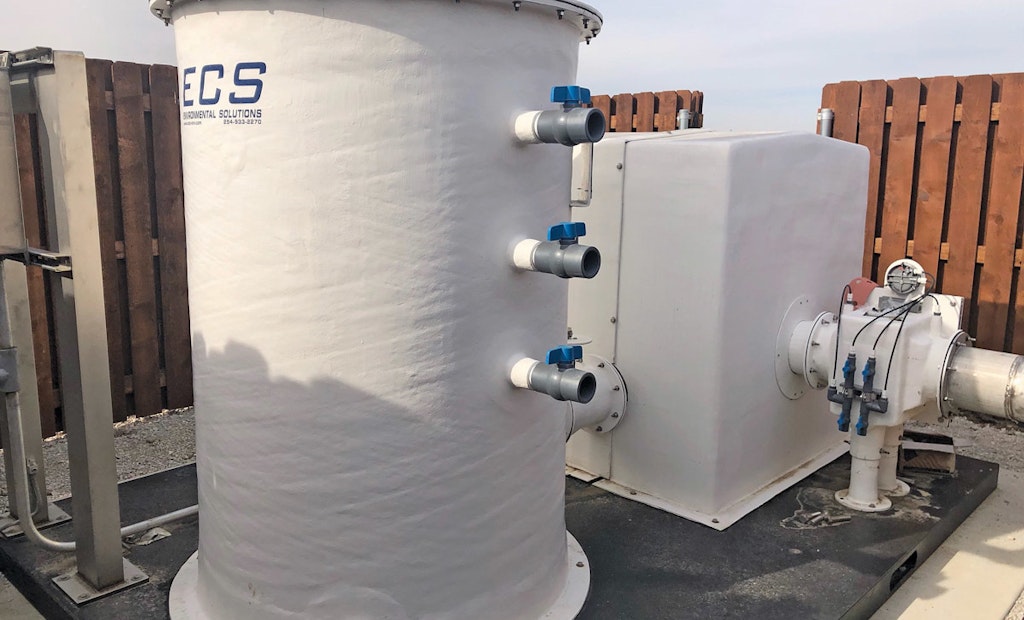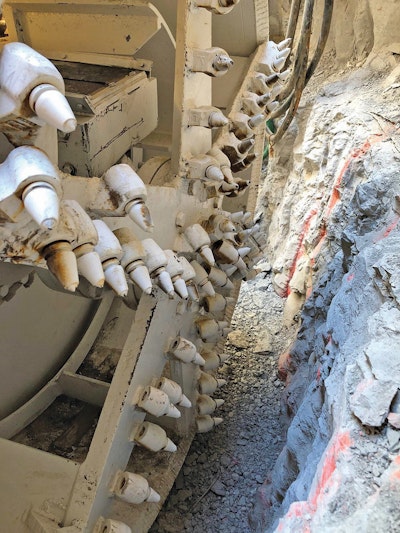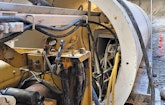
The North Texas Municipal Water District installed two odor control systems from ECS Environmental Solutions during construction of the large-diameter Beck Branch Parallel Relief Interceptor in Plano, Texas.
Interested in Infrastructure?
Get Infrastructure articles, news and videos right in your inbox! Sign up now.
Infrastructure + Get AlertsBuilding a sewer line in an urban area with minimal disruption to residents and businesses is a difficult task. Doing it in a tight corridor with multiple conflicting utilities, high-profile intersections and active railroad crossings is even more challenging.
The North Texas Municipal Water District faced all those obstacles when it decided to construct a parallel relief interceptor in Plano, Texas, but careful planning and execution have kept the project moving smoothly.
Over the last decade, Plano and its neighboring city, Richardson, have grown rapidly. The cities offer outstanding business and employment opportunities, schools, libraries, civic organizations and other resources that attract thousands of people every year. High-profile corporations such as State Farm, Frito-Lay, Toyota, Pizza Hut and NTT Data have established offices in the region, spawning residential and mixed-use development. This surge in population has increased current and future demands on the region’s sewer system. To meet these demands, forward-thinking officials at NTMWD identified a series of wastewater projects. The relief interceptor project was one of them.
“An evaluation we did in 2015 showed that we needed additional capacity in the existing Beck Branch Interceptor to meet current peak and projected flows,” says Bret Ellis, P.E., engineering manager at NTMWD. “Our existing 54-inch gravity interceptor was about to reach full capacity, so building a relief interceptor that would supplement current capacity was critical.”
Planning considerations
The NTMWD was established in 1951 when 10 member cities decided to collaborate to provide water during one of the most devastating droughts in state history. In 1956, NTMWD provided water to 32,000 people. Today, the district serves 13 member cities and provides vital water, wastewater and solid waste management services to more than 1 million people. The district operates a wastewater collections system that consists of approximately 226 miles of large-diameter wastewater pipelines, 23 lift stations and various support facilities. This regional partnership has reduced costs, facilitated access to these services for communities large and small, and streamlined service delivery.
Following its 2015 evaluation, the district contracted Lockwood, Andrews & Newnam, a national planning, engineering and program management firm, to begin the preliminary engineering phase of the relief interceptor. The firm performed a hydraulic study and evaluated several alternatives to determine the most viable option. For each alternative, the firm considered a range of factors, including system shutdowns, capital costs, phasing, annual operations and maintenance, right-of-way restrictions, constructability and impacts to the city of Plano. The firm also conducted an exhaustive route study to select the project corridor.
“This whole corridor is a complex system of pipelines,” says Justin Reeves, P.E., LAN’s vice president. “Several lift stations and force mains pump flows into the existing interceptor and, ultimately, to the Rowlett Creek Wastewater Treatment Plant. In addition, there is a parallel force main that carries flows directly to the treatment plant. We looked at numerous options such as replacing the existing interceptor with a larger pipeline, changing interceptors to force mains, and changing force mains to interceptors. The idea was to find a solution that maximized the previous investment in existing assets and achieved capacity goals at the same time.”
During the planning phase, engineers evaluated pipe diameters and interconnections, depth of the pipe, construction method, utility conflicts, traffic and business impacts, and easement acquisition costs. “We also coordinated with member cities, especially the city of Plano, to get their input because the alignments we were evaluating went under Plano Parkway, one of the city’s major roads,” says Lauren Kubin, P.E., the district’s wastewater conveyance engineer.
Following the hydraulic analysis and route study, the district determined that a parallel relief interceptor segment, now known as the Beck Branch Parallel Interceptor, was the best option. The district also decided to install the interceptor within the Plano Parkway right-of-way as it met the project objectives with the fewest negative impacts. Furthermore, the district decided to break the $26.7 million interceptor project into two phases.
The $5.7 million first phase, which was substantially completed in March 2021, addresses the district’s immediate needs and provides an additional capacity of approximately 57 mgd. Traversing along Los Rios Boulevard from the Rowlett Creek Wastewater Treatment Plant to Plano Parkway, this phase includes a 3/4-mile segment consisting of 868 linear feet of 42-inch fiber-reinforced plastic gravity sewer, 2,900 linear feet of 54-inch FRP gravity sewer, two active odor control systems, a live flow tie-in and a connection to the treatment plant. The segment runs parallel to the existing gravity interceptor.
The $21 million second phase, currently under construction, consists of approximately 18,000 linear feet of 42-inch FRP pipe from the intersection of Los Rios Boulevard and East Plano Parkway to a connection point near Plano Spring Creek Lift Station No. 2. This segment, which has a capacity of 52 mgd, will address the district’s long-term needs. The segment parallels a major transportation corridor.
Complex challenges
The final engineering phase began in May 2018. Belt Construction, the Phase 1 contractor, started construction in February 2019. The complex nature of the project created numerous design and construction challenges. Chief among them was navigating around multiple utilities in the congested urban corridor. In addition to the existing sewer lines, the corridor also has waterlines, gas lines, power transmission lines and fiber-optic cables.
“Initially, we looked at installing the interceptor using opencut methods,” Reeves says. “We ran multiple analyses to see if the interceptor could stay within a limited easement while still preventing parallel pipe trench impacts. We were looking at installation depths of 40 to 50 feet in some areas. We wanted to minimize impacts to traffic and businesses in the area, so we evaluated the cost differences between opencut and tunneling. After considering these factors, we recommended tunneling for most of the project.”
The team made an extra effort to put correct requirements in the contracting documents to minimize traffic impacts. “Building on previous experiences in the area, we scheduled and sequenced the project in such a way that we would impact only certain areas and not shut down the street at any given time,” Ellis says.
In September 2019, Circle H Contractors began tunneling at Capital One Bank, heading south toward Plano Parkway. For the tunneling, Circle H utilized an electric tunnel boring machine, crane, excavator and wheel loader. Once the boring machine was calibrated, digging began and operated 24 hours per day for maximum efficiency.
“The most difficult aspects included the depth of the tunnels, limited space to access shafts, specifically in the parking lot of Capital One Bank located at 14th Street and Los Rios Boulevard, and the considerable amount of construction in the near vicinity,” says Trey Linzay, project manager at Belt Construction.
To navigate these issues, Belt Construction worked closely with Circle H and the inspection team to ensure the tunnels were bored quickly and efficiently while adhering to rigid safety standards. In addition, Circle H installed a circular 25-foot-diameter access shaft to minimize the footprint, and the excavation was barricaded properly to avoid interfering with the day-to-day business of Capital One Bank and ensure the safety of its patrons. Regular coordination meetings were held between the projects’ supervisors, as well as clear and frequent communication among all those involved. The tunnel, which encompassed 1,630 feet, was completed in early March 2020 at the intersection of Los Rios Boulevard and East Plano Parkway.
The district also wanted to avoid bypass pumping during the construction of a new overflow connection to the existing interceptor system. Installing bypass piping that could handle an average daily flow of approximately 55 mgd was not only expensive but would require lane closures at Plano Parkway, adverse impacts to businesses, and a risk for odor emissions. To solve this challenge, the project team designed a creative live-flow connection to the existing interceptor.
“We designed an overflow weir that essentially served as a new manhole over the existing interceptor,” Reeves says. “This design allowed the contractor to cut a hole on top of the existing interceptor in such a way that once flows reached a certain level, it would flow out of the pipe into the new parallel interceptor. We worked closely with district operations to understand flow while developing the design. We estimate it saved more than a million dollars compared to traditional methods that rely on bypass pumping.”
With the interceptor terminating at the treatment plant, minimizing surcharges was also a concern due to the immediately upstream hydraulic grade line. To prevent surcharges, the project team designed the end of the line with a steeper slope to deter solids deposition in the pipe. The team also installed two active odor control systems, one at the parallel interceptor interconnect location and another at the treatment plant’s junction box.
“When you have a submerged discharge, the odor has nowhere to go except back up the system,” Kubin says. “Normally, we install passive odor cans on our interceptor systems. But for this project, we chose to install active control systems that would pull the gases out of the sewer line and filter it. The district is very odor-conscious, and we want to be good neighbors to our member cities.”
The interceptor also passes through an active railroad crossing owned by the Dallas Area Rapid Transit and operated by the Kansas City Southern Railway. Typically, railroads require a steel casing for utilities installed under their crossings to prevent settlement. During design, the project team coordinated with DART and Kansas City Southern to obtain an exception to use tunnel liner plate instead. This coordination continued during the construction process when flaggers were used for worker safety.
Next phase
Despite these challenges, NTMWD reached substantial completion of the first phase of the project on time and under budget. The first segment, which went into service in March 2021, will provide the district the ability to meet the corridor’s immediate peak flow demands. Construction is in full swing on the second phase of the project, says Andrew Stevens, P.E., wastewater conveyance program manager at NTMWD.
“There are 15 tunnels to construct in the second phase,” Stevens says. “The pipeline will be constructed within the median of Plano Parkway, across a DART rail line and Union Pacific Railroad, and under road intersections and several critical utilities. The contractor has multiple crews working concurrently and our inspectors are on site full time.”
Phase 2 is scheduled for completion in March 2022. Stevens credits the team’s planning efforts with the project’s success to this point.
“We have established and maintained frequent collaboration and communications with project stakeholders on our progress,” Stevens says. “We haven’t received any public or traffic complaints to date. That’s one key indicator of success in my mind.”
Concurrently, work is underway on another gravity interceptor that will facilitate the decommissioning of an existing lift station and transfer flows to the Plano Spring Creek Lift Station No. 2, which discharges into Phase 2 of the parallel relief interceptor project. The district is also expanding Plano Spring Creek Lift Station No. 2 to accommodate the flows. Together, these projects will meet the corridor’s capacity needs until 2035.
About the Author
Grace Sober, P.E., is a project manager at Lockwood, Andrews & Newnam, a national planning, engineering and program management firm. She can be reached at GDSober@lan-inc.com.









